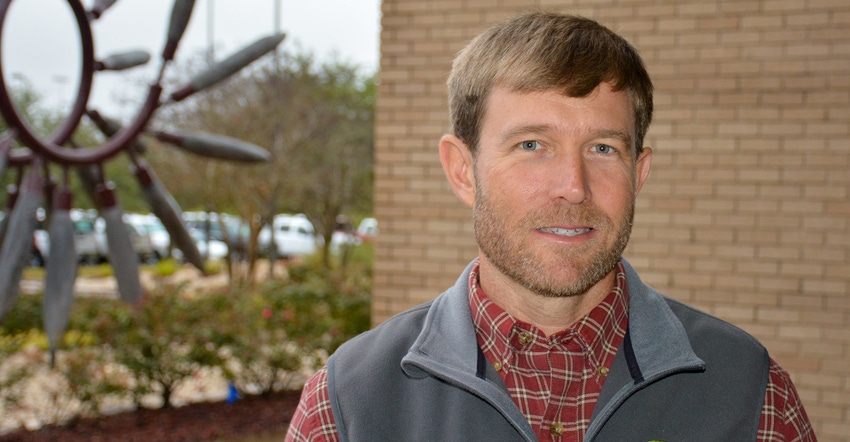
Machines are smarter than they used to be. In fact, spray units now in use can identify a weed in a cotton field 3 feet ahead, calculate ground speed, environmental conditions and in a matter of milliseconds decide to spray herbicide in a 3-inch pattern that covers only that one weed.
Artificial intelligence, AI, says Shannon Pickering, Blue River Technology, Sunnyvale, Cal., is already improving farm efficiency.
Pickering, during the opening session of the 31st annual Texas Plant Protection Association Conference Dec. 10, in Bryan, explained how AI is and will continue to change how farmers manage crops.
See, AI will improve on-farm decision-making
He says the concept of farm machinery as "dumb iron," no longer holds. The process began with what now might be considered rudimentary steps with auto-steer, variable rate fertility and seeding and yield monitors. GPS units now come standard on most farm implements.
Artificial intelligence builds on that base, using data collected through sensors, GPS coordinates and human observation to add layers of information to computer platforms that are capable of making decisions on the go.
Pickering anticipates a time, soon, when equipment manufacturers will include AI capabilities on every implement they sell.
See and spray
He discussed Blue River's See and Spray technology at the TPPA conference two years ago. He offered updates. See and Spray, he explains, uses sensors to differentiate weeds from crops and targets the weed for elimination. The process occurs in a virtual blink of the eye as the sprayer moves through the field.
"We hope to improve the technology to function at 10 miles per hour," Pickering says.
He also notes that AI on a combine already in use assesses grain loss on the go and adjusts to compensate.
"Artificial intelligence is used everywhere," he adds. "We see a lot of opportunities in agriculture."
Data driven
John Deere, which acquired Blue River recently (leaving the Blue River entity intact), recognizes the possibilities, Pickering says. He anticipates a time in the near future when Deere will include AI on every platform they put in the field. "Machines are now smarter and more efficient. AI gives machines the ability to sense and make decisions on what to do. It's all based on data.
"Data drive the process. We have massive amounts of data, but the problem has been how to use it. Now, AI allows machines to churn through multiple layers of data in a millisecond."
Machine learning, data processing and sensing results in decisions, Pickering says.
See, Juan Landivar receives Norman Borlaug Lifetime Achievement Award
He explained that See and Spray began with trials in lettuce fields, a 12-month crop in California, so they had on-going opportunities to test and evaluate. "We used lettuce to figure out how the system works," he says.
They taught the machine to identify individual plants. Then they moved into cotton. "Cotton was ground zero for resistant weed problems," Pickering says. "Cotton seemed to be the crop that needed the most help. We are expanding to corn and soybeans."
AI and ag opportunities
He sees See and Spray in particular, and artificial intelligence in general, offering farmers an opportunity to improve efficiency. "Labor is a big issue," he says. "AI trains machines to do the job more efficiently, which means more production and optimizing inputs."
Agriculture, Pickering says, creates and collects a lot of information. To develop useful AI platforms, humans have to train the machines. He says it's similar to how an agronomist learns his trade. He observes plants, learns to identify crops and weeds at all stages of growth, so when he sees a pigweed, he knows what it is.
Teaching machinery follows the same path, using images. AI developers collect hundreds of thousands of images of crops and every weed they can identify to develop the database they put into the machine.
Training computers
"We train computers, not just program them," Pickering says. "It consists of deep learning, layers and layers of data and multiple subsets of images. Good data are crucial."
He says when an agronomist identifies a new weed, someone has to retrain the machine. "Also, cotton looks different, depending on the region where it's grown."
See, AI will improve on-farm decision-making
He says they tested See and Spray in Australia and killed a lot of cotton because the cotton plants in Australia look different than the plants grown in the U.S. Plants grown in the Lower Rio Grand Valley also differ from those grown in the High Plains or in the Mid-South. The computer needs images of all those cotton types, at various growth stages, to differentiate weeds from crops.
Plant-by-plant
Pickering says in the future artificial intelligence will allow plant-by-plant management. "Technology will have the ability to look at every plant in the field. We will have new tools to fight resistant weeds and that make real-time decisions that optimize growers' input budgets."
Imagery, he says, makes a difference. Satellite images are taken from space. Aerial imagery gets closer and UAVs may offer even better resolution. But sensors on the machine, cameras situated within a few feet or a few inches of the plants, provide close-up views, close enough to detect plant health issues.
Pickering says artificial intelligence will not displace boots in the field or replace crop consultant services. "Smart machines," he says, "will help them make decisions."
About the Author(s)
You May Also Like






